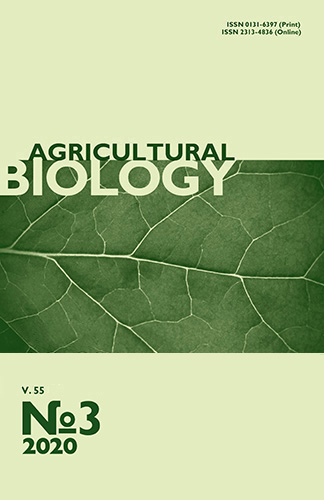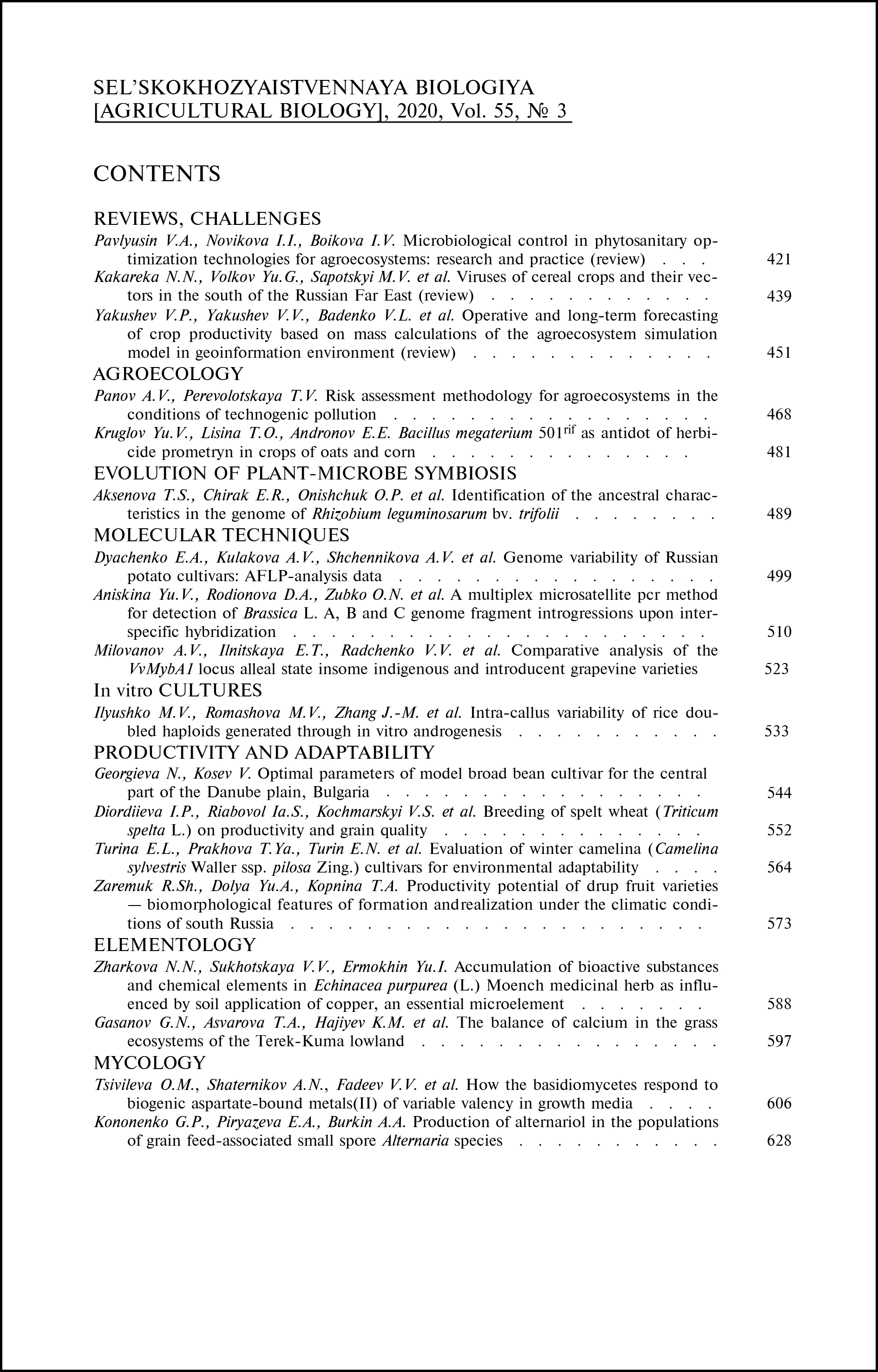doi: 10.15389/agrobiology.2020.3.628eng
UDC: 636.085.19:636.086.1/.3:632.4
PRODUCTION OF ALTERNARIOL IN THE POPULATIONS OF GRAIN FEED-ASSOCIATED SMALL SPORE Alternaria SPECIES
G.P. Kononenko, E.A. Piryazeva, A.A. Burkin
All-Russian Research Institute for Veterinary Sanitation, Hygiene and Ecology — Branch of FSC ARRIEV RAS, 5, Zvenigorodskoe sh., Moscow, 123022 Russia, e-mail kononenkogp@mail.ru (✉ corresponding author), piryazeva01@yandex.ru, aaburkin@mail.ru
ORCID:
Kononenko G.P. orcid.org/0000-0002-9144-615X
Burkin A.A. orcid.org/0000-0002-5674-2818
Piryazeva E.A. orcid.org/0000-0001-5443-3213
Received February 18, 2020
Modern science has strong evidence that Alternaria fungi pose a serious toxic hazard. Alternaria species can grow well on various substrates and in a wide range of temperatures and humidity, occupying different ecological niches in this way, and can produce several types of especially dangerous secondary metabolites(S.M. Tralamazza et al., 2018). The most well-studied Alternaria mycotoxin alternariol (AOH), a dibenzo-a-pyron derivative, exhibits high cytotoxicity, genotoxic and mutagenic effects (Z. Mao et al., 2014). However, the ability of Alternaria fungi to produce this toxin still remains poorly studied. In Russia, a significant prevalence of small spore Alternaria species on grain crops (Ph.B. Gannibal, 2004, 2006; T.Yu. Gagkaeva et al., 2012), and an increase in the frequency of Alternaria occurrence and AOH accumulation in grain and feed mixtures (G.P. Kononenko et al., 2019, 2020) have been recently reported. In this article, we first showed that the species A. tenuissima, A. alternata, and A. arborescens can cause AOH contamination of grain feeds. The work aims to investigate AOH production by the grain feed-associated Alternaria species. Alternaria fungi were isolated from 57 feed samples of different types (wheat, barley, corn and oats, sunflower seeds, wheat bran and mixed feeds). Monoconidial isolates identified by morpho-cultural features as A. tenuissima (Nees et T. Nees: Fries) Wiltshire, A. alternata (Fr.) Keissl, and A. arborescens E.G. Simmons, and another 14 isolates assigned to A. infectoria species group were cultured for 7 days at 25 °С on a panel of 4 mycological media, the potato-carrot agar (PCA), hay infusion agar (HAY), malt extract agar (MEA), and vegetable juice agar (V-8). AOH was detected in extracts using a certified commercial kit for indirect competitive enzyme-linked immunosorbent assay (ELISA). Among the isolates belonging to A. infectoria species group, 13 were devoid of producing ability while for one of them the accumulation of AOН was observed on all growth media in quantities 2.0±0.2, 14±3, 18±4 and 220±30 μg/g, respectively. Evaluation of the biosynthetic potential of A. tenuissima and A. alternata showed the highest degree of its realization on MEA growth medium in terms of the total number of producers and the share of highly active and superactive isolates. The total amount of AOH accumulation in these conditions for both species was almost the same and amounted to 73 and 71 μg/g, respectively. A. arborescens isolates provided the highest AOH production on V-8, HAY, and MEA media in amounts equal to 106, 64, and 31 μg/g, respectively. The peculiarities of metabolic response of A. tenuissima, A. alternata and A. arborescens species to environmental changes and a rapid method to assess toxigenicity of Alternaria fungi during taxonomic identification are discussed.
Keywords: alternariol, Alternaria tenuissima, Alternaria alternata, Alternaria arborescens, Alternaria infectoria species group, grain feeds, ELISA.
REFERENCES
- Tralamazza S.M., Piacentini K.C., Iwase C.H.T., De Oliveira Rocha L. Toxigenic Alternaria species: impact in cereals worldwide. Current Opinion in Food Science, 2018, 23: 57-63 CrossRef
- Ostry V. Alternaria mycotoxins: an overview of chemical characterization, producers, toxicity, analysis and occurrence in foodstuffs. World Mycotoxin Journal, 2008, 1(2): 175-188 CrossRef
- EFSA on Contaminants in the Food Chain (CONTAM). Scientific opinion on the risks for animal and public health related to the presence of Alternaria toxins in feed and food. EFSA Journal, 2011, 9(10): 2407 CrossRef
- Lou J., Fu L., Peng Y., Zhou L. Metabolites from Alternaria fungi and their bioactivities. Molecules, 2013, 18(5): 5891-5935 CrossRef
- Lee H.B., Patriarca A., Magan N. Alternaria in food: ecophysiology, mycotoxin production and toxicology. Mycobiology, 2015, 43(2): 93-106 CrossRef
- Mao Z., Sun W., Fu L., Luo H., Lai D., Zhou L. Natural dibenzo-a-pyrones and their bioactivities. Molecules, 2014, 19(4): 5088-5108 CrossRef
- Patriarca A., Azcarate M.P., Terminiello L., Fernández Pinto V. Mycotoxin production by Alternaria strains isolated from Argentinian wheat. International Journal of Food Microbiology, 2007, 119(3): 219-222 CrossRef
- Mašková Z., Tančinová D., Barboráková Z., Felšöciová S., Cisarová M. Comparison of occurrence and toxinogenity of Alternaria spp. isolated from samples of conventional and new crossbred wheat of Slovak origin. Journal of Microbiology, Biotechnology and Food Sciences, 2012, 1(4): 552-562 CrossRef
- Oviedo M.S., Sturm M.E., Reynoso M.M., Chulze S.N., Ramirez M.L. Toxigenic profile and AFLP variability of Alternaria alternata and Alternaria infectoria occurring on wheat. Brazilian Journal of Microbiology, 2013, 44(2): 447-455 CrossRef
- Andersen B., Nielsen K.F., Fernández Pinto V., Patriarca A. Characterization of Alternaria strains from Argentinean blueberry, tomato, walnut and wheat. International Journal of Food Microbiology, 2015, 196: 1-10 CrossRef
- Ramires F.A., Masiello M., Somma S., Villani A., Susca A., Logrieco A.F., Luz C., Meca G., Moretti A. Phylogeny and mycotoxin characterization of Alternaria species isolated from wheat grown in Tuscany, Italy. Toxins, 2018, 10(11): 472 CrossRef
- Li F., Toyazaki N., Yoshizawa T. Production of Alternaria mycotoxins by Alternaria alternata isolated from weather-damaged wheat. Journal of Food Protection, 2001, 64(4): 567-571 CrossRef
- Nguyen T.T.T., Kim J., Jeon S.J., Lee C.W., Magan N., Lee H.B. Mycotoxin production of Alternaria strains isolated from Korean barley grains determined by LC-MS/MS. International Journal of Food Microbiology, 2018, 268: 44-52 CrossRef
- Zwickel T., Kahr S.M., Rychlik M., Müller E.H. Chemotaxonomy of mycotoxigenic small-spored Alternaria fungi — do multitoxin mixtures act as an indicator for species differentiation? Frontiers in Microbiology, 2018, 9: 1368 CrossRef
- Andersen B., Thrane U. Secondary metabolites produced by Alternaria infectoria and their use as chemotaxonomic markers. Mycotoxin Research, 1996, 12(2): 54-60 CrossRef
- Andersen B., Thrane U. Differentiation of Alternaria infectoria and Alternaria alternata based on morphology, metabolite profiles, and cultural characteristics. Canadian Journal of Microbiology, 1996, 42(7): 685-689 CrossRef
- Andersen B., Krøger E., Roberts R.G. Chemical and morphological segregation of Alternaria alternata, A. gaisen and A. longipes. Mycological Research, 2001, 105(3): 291-299 CrossRef
- Pinto V.F., Patriarca A. Alternaria species and their associated mycotoxins. In: Mycotoxigenic Fungi: Methods in Molecular Biology, vol. 1542. A. Moretei, A. Susca (eds.). Humana Press, New York, NY, 2017: 13-32 CrossRef
- Lawrence D.P., Rotondo F., Gannibal P.B. Biodiversity and taxonomy of the pleomorphic genus Alternaria. Mycological Progress, 2016, 15(1): article 3 CrossRef
- Gannibal Ph.B., Yli-Mattila T. Mikologiya i fitopatologiya, 2005, 39(4): 13-23 (in Russ.).
- Frisvad J.C., Smedsgaard J., Larsen T.O., Samson R.A. Mycotoxins, drugs and other extrolites produced by species in Penicillium subgenus Penicillium. Studies in Mycology, 2004, 49: 201-241.
- Frisvad J.C., Hubka V., Ezekiel C.N., Hong S.-B., Nováková A., Chen A.J., Arzanlou M., Larsen T.O., Sklenár F., Mahakarnchanakul W., Samson R.A., Houbraken J. Taxonomy of Aspergillus section Flavi and their production of aflatoxins, ochratoxins and other mycotoxins. Studies in Mycology, 2019, 93: 1-63 CrossRef
- Simmons E.G. Alternaria. An identification manual. CBS, Utrecht, 2007.
- Introduction to food- and airborne fungi. R.A. Samson, E.S. Hoekstra, J.S. Frisvad, O. Filtenborg (eds.). CBS, Utrecht, 2000.
- Burkin A.A., Kononenko G.P. Immunopatologiya, allergologiya, infektologiya, 2009, 2: 7-8 (in Russ.).
- Gannibal F.B. Mikologiya i fitopatologiya, 2004, 38(3): 19-28 (in Russ.).
- Gannibal F.B. Mikologiya i fitopatologiya, 2008, 42(4): 359-368 (in Russ.).
- Gagkaeva T.Yu., Gannibal F.B., Gavrilova O.P. Zashchita i karantin rastenii, 2012, 1: 37-42 (in Russ.).
- Piryazeva E.A., Kononenko G.P. Materialy chetvertogo s"ezda mikologov Rossii «Sovremennaya mikologiya v Rossii», vol. 7 [Proc. Fourth Congress of Russian mycologists «Modern mycology in Russia»]. Moscow, 2017: 175-177 (in Russ.).
- Ustyuzhanina M.I., Burkin A.A., Kononenko G.P., Piryazeva E.A., Zotova E.V. Alternative assay media for alternariol production by Alternaria species. Proc. of the VIII International Conference on Environmental, Industrial and Applied Microbiology — BioMicroWorld2018 «Global progress in applied microbiology: a multidisciplinary approach». A. Méndez-Vilas (ed.). Formatex Research Center, Badajoz, Spain, 2018: 1-5.
- Kononenko G.P., Ustyuzhanina M.I., Orina A.S. Multi-substrate screening the ability to produce alternariol among Alternaria arborescens strains. Journal of Veterinary Science & Technology, 2019, 10: 41-42.
- Andersen B., Krøger E., Roberts G. Chemical and morphological segregation of Alternaria arborescens, A. infectoria and A. tenuissima species-groups. Mycological Research, 2002, 106(2): 170-182 CrossRef
- Andersen B., Sørensen J.L., Nielsen K.F., van den Ende B.G., de Hoog S. A polyphasic approach to the taxonomy of the Alternaria infectoria species-group. Fungal Genetics and Biology, 2009, 46: 642-656 CrossRef
- Patriarca A., da Cruz Cabral L., Pavicich M.A., Nielsen K.F., Andersen B. Secondary metabolite profiles of small-spored Alternaria support the new phylogenetic organization of the genus. International Journal of Food Microbiology, 2019, 291: 135-143 CrossRef
- Kostecki M., Grabarkiewicz-Szczẹsna J., Chelkowski J. Biosynthesis and preparation of five Alternaria metabolites. Mycotoxin Research, 1991, 7(1): 3-7 CrossRef
- Häggblom P., Hiltunen M. Regulation of mycotoxin biosynthesis in Alternaria. Mycotoxin Research, 1991, 7(1): 8-10 CrossRef
- Oviedo M.S., Ramirez M.L., Barros G.G., Chulze S.N. Impact of water activity and temperature on growth and alternariol and alternariol monomethyl ether production of Alternaria alternata isolated from soybean. Journal of Food Protection, 2010, 73(2): 336-343 CrossRef
- Kosiak B., Torp M., Skjerve E., Andersen B. Alternaria and Fusarium in Norwegian grains of reduced quality — a matched pair sample study. International Journal of Food Microbiology, 2004, 93(1): 51-62 CrossRef
- Logrieco A., Bottalico A., Solfrizzo M., Mulé G. Incidence of Alternaria species in grains from Mediterranean countries and their ability to produce mycotoxins. Mycologia, 1990, 82(4): 501-505 CrossRef
- Kononenko G.P., Burkin A.A., Zotova E.V., Smirnov A.M. Rossiiskaya sel'skokhozyaistvennaya nauka, 2019, 3: 28-31 CrossRef (in Russ.).
- Kononenko G.P., Burkin A.A., Zotova E.V. Veterinariya segodnya, 2020, 1(32): 60-65 CrossRef (in Russ.).












